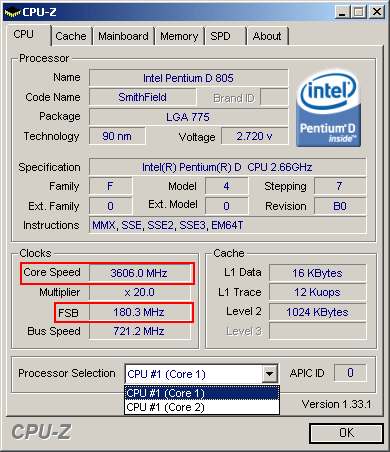A 4.1 GHz Dual Core at $130 - Can it be True?
Trouble Free Operation At 3.60 GHz
Now, we're slowly working our way into the interesting clock rates, and finally exceeding the performance of the Pentium Extreme Edition 840 CPU, which operates at 3.2 GHz. This CPU costs a little over $1,000 at retail, so we've saved about $870 by using a Pentium D 805 instead. We still require no additional voltage boost at this speed, and the CPU remains stable in performing our benchmarks.
At retail computer outlets, a Pentium EE 840 goes for something north of $1,000.
Naturally, the EE 840 runs with an FSB clock rate that's 20 MHz higher and also offers Hyper Threading. The Pentium D 805 is running at a CPU clock rate that's 200 MHz faster, however, so it has no trouble keeping up.
Overclocking the FSB clock rate to 180 MHz improves memory performance. The highest memory clock at our disposal is 360 MHz, because a maximum memory multiplier of 4.0 translates into DDR2-720. Thus, we improved memory performance by 35 percent, as company to the original memory clock rate.
Now we observe a noticeable increase in power consumption for the entire system. In idle mode, energy use climbs by 33 W; we also measured 204 W of power consumption from the power supply. Under heavy load, power consumption increases by a hefty 101 W. In considering the fact that about 80 percent of this 101 W goes to the CPU, we observe that energy consumption at 3.6 GHz has doubled to 160 W. We find ourselves here running at nearly 30 W above the maximum power class for dual core processors based on this CPU core, according to Intel's specifications.
Get Tom's Hardware's best news and in-depth reviews, straight to your inbox.
Current page: Trouble Free Operation At 3.60 GHz
Prev Page 3.33 GHz Remains Stable At Standard Voltage Levels, Continued Next Page At 3.8 GHz Some Minor Voltage Increases Become NecessaryTom's Hardware is the leading destination for hardcore computer enthusiasts. We cover everything from processors to 3D printers, single-board computers, SSDs and high-end gaming rigs, empowering readers to make the most of the tech they love, keep up on the latest developments and buy the right gear. Our staff has more than 100 years of combined experience covering news, solving tech problems and reviewing components and systems.
-
Tnias I am quite interested in your post regarding the D 805. Considering that it is now available for around $60.00 (03/20/09), it still sounds like a steal. We just upgraded our Adobe CS2 software to the new CS4 Master Suite, which caused the need for a graphics card upgrade. We have an nVidia GeForce GTX 260, but haven't installed it because our computer is a HP Media Center PCm7350n computers each with a 2.8 GHz CPU on a ASUS P5LP-LE mobo. Your article seemed to imply that there is software available that might adjust the clock from inside windows and we are wondering if it can on that mobo or if we will have to get a different mobo. If so, we are wondering what might be our most cost effective but stable options. We are certainly going to need a new power supply for the GTX 260, which requires 525 Watts. We are looking at just putting in PC Power & Cooling’s, Silencer 610 EPS12V power supplyand letting it go at that, but we are also thinking about upgrading the CPU and mobo if necessary.Reply
Of course, we would like to keep the cost down as much as possible.
We have no idea where the best bang for the buck will be. For us a stable system is more important than blazing speed. Thus, the HP's worked fine for what we originally got them for; it’s just that our graphics and video production software are forcing upgrades in speed and power.
The D850 chip sounds incredible and the power supply we already have to get will handle overclocking that chip. It even sounds like that chip will work in the existing mobo if we can find a way to change the clock speed from inside windows instead of from the BIOS. HP BIOS does not allow adjusting the clock speed in the BIOS but can't BIOS just be changed as well; isn't it just an EPROM?
Anyway, even if we opt for changing out the mobo for another case compatible Asus mobo, we still have to answer the question of which board and chip combination will give us the most stable service for the least cost.
Any ideas that might help us plan the most appropriate upgrade and the least cost? -
amnotanoobie TniasAny ideas that might help us plan the most appropriate upgrade and the least cost?Reply
With the price of components that you need to make this run stable, and the amount of electricity that this would use, a cheap Core 2 and motherboard and DDR2 memory would cost you less in the long run.
Example:
Intel Pentium Dual Core E5200
Kingston DDR2 2x2GB 800MHz
Gigabyte G31M-ES2C
This should cost less than $200.


